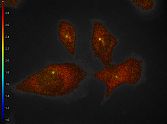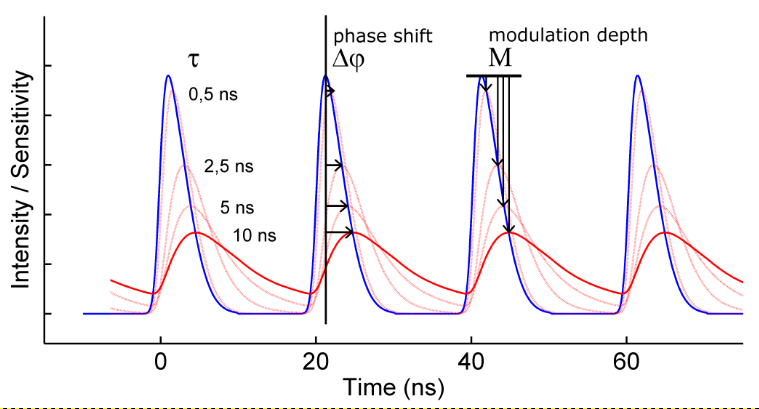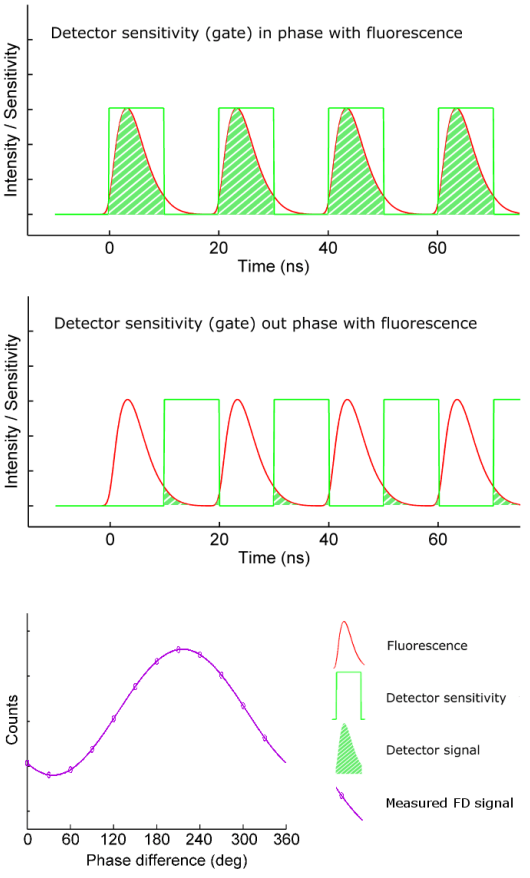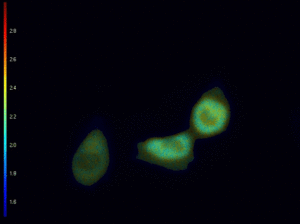< Back
Intensifier Control
Frequency-Domain FLIM for Beginners
Fluorescence lifetime imaging microscopy (FLIM) can be performed in the time domain and in the frequency domain. Scanning single point lifetime detection units on confocal laser scanning microscopes mainly operate in the time domain. Camera-based lifetime detection on widefield, multi-beam confocal and total internal reflection fluorescence (TIRF) microscopes operate both in time domain and frequency domain. The Lambert Instruments LIFA for example is a fast frequency-domain system, whereas the Lambert Instruments TRiCAM can be operated both in the frequency and time domains.
Time Domain
In the time domain the fluorescence decay can be measured by using time-correlated single photon counting (TCSPC) or fast-gated image intensifiers. A measurement requires short excitation pulses of high intensity and fast detection circuits. Each point in the sample is excited sequentially. TCSPC records a histogram of photon arrival times at each spatial location using Photo Multiplier Tubes (PMTs) or comparable single photon counting detectors. Fast-gated image intensifiers measure fluorescence intensity in a series of different time windows. With both time domain techniques lifetimes are derived from exponential fits to the decay data. When sufficient channels (time windows) are used, multi-exponential lifetimes can be extracted.

Fluorescence lifetime imaging microscopy (FLIM) can be performed in the time domain and in the frequency domain. Scanning single point lifetime detection units on confocal laser scanning microscopes mainly operate in the time domain. Camera-based lifetime detection on widefield, multi-beam confocal and total internal reflection fluorescence (TIRF) microscopes operate both in time domain and frequency domain. The Lambert Instruments LIFA for example is a fast frequency-domain system, whereas the Lambert Instruments TRiCAM can be operated both in the frequency and time domains.
Time Domain
In the time domain the fluorescence decay can be measured by using time-correlated single photon counting (TCSPC) or fast-gated image intensifiers. A measurement requires short excitation pulses of high intensity and fast detection circuits. Each point in the sample is excited sequentially. TCSPC records a histogram of photon arrival times at each spatial location using Photo Multiplier Tubes (PMTs) or comparable single photon counting detectors. Fast-gated image intensifiers measure fluorescence intensity in a series of different time windows. With both time domain techniques lifetimes are derived from exponential fits to the decay data. When sufficient channels (time windows) are used, multi-exponential lifetimes can be extracted.
Frequency Domain
The frequency-domain FLIM technique requires a modulated light source and a modulated detector. The excitation light is modulated or pulsed in intensity at a certain radio frequency (the blue curve in the figure below). The induced fluorescence emission will mirror this modulation pattern and show, due to the fluorescence decay, a delay in time in the form of a phase-shift (the red curve). In addition, the modulation depth will decrease with respect to the excitation light, while the average intensity remains the same. The phase-shift and modulation-depth directly depend on the fluorescence lifetime and the known modulation frequency (see figure).
To extract the phase shift and modulation depth from the fluorescence emission signal, a homodyne detection method is often used. In this method the sensitivity of the detector – often an intensified camera – is modulated (or gated) with the same radio frequency as the light source (the green curve in the figure on the right). For a camera detector the result is an intensity image with a fixed brightness. By shifting the phase of the image intensifier with respect to the light source in a series of fixed steps a low-pass signal is generated for each pixel: the output image will be brighter or dimmer depending on whether the detector sensitivity is in or out of phase with the fluorescence emission. The result is a frequency-domain FLIM signal as a function of the phase difference between light source and camera (purple curve in the figure on the right) for each pixel in the image.
The key is that this frequency-domain signal (purple curve) exactly mirrors the phase shift and demodulation in the time domain. The phase and modulation depth can be directly extracted from the measurements and are the fundamental data in a homodyne FD FLIM measurement.
From the acquired modulation depth and phase shifts, two independent determinations of the fluorescence lifetime can be calculated. For an absolute determination the system needs to be calibrated at the pixel level with a reference fluorophore of known lifetime. For this calibration the only requirement is a FLIM acquisition of the reference fluorophore with known lifetime (figure on the right).
Multi-Exponential Decay
Some fluorophores have a multi-exponential decay, consisting of two or more lifetime components. For example, the decay of CFP is bi-exponential. These multiple lifetime components can be separated and extracted using multiple frequency measurements and the polar (or phasor) plot.
Advantages of Frequency-domain FLIM
The key advantage of frequency-domain FLIM is its fast lifetime image acquisition making it suitable for dynamic applications such as live cell research: the entire field of view is excited semi-continously – using relatively broad excitation pulses – and read out simultaneously. Hence frequency domain lifetime imaging can be near instantaneous. Another advantage of a camera-based FLIM setup, such as the Lambert Instruments LIFA, is its ease of use and its low maintenance requirements. For more information about our products, please visit the FLIM product pages and our FLIM software page.






